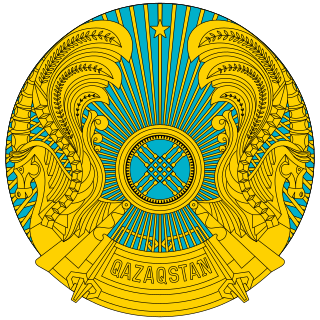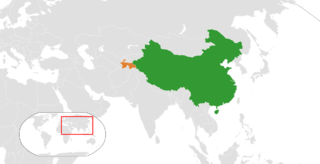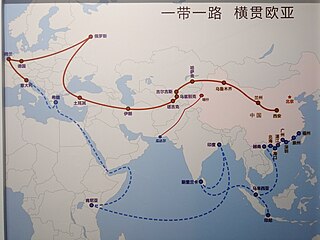
Foreign relations of Kazakhstan are primarily based on economic and political security consideration. The Nazarbayev administration has tried to balance relations with Russia and the United States by sending petroleum and natural gas to its northern neighbor at artificially low prices while assisting the U.S. in the War on Terror. Kazakhstan is a member of the United Nations, Collective Security Treaty Organization, Organization for Security and Co-operation in Europe, North Atlantic Cooperation Council, Commonwealth of Independent States, the Shanghai Cooperation Organisation, and NATO's Partnership for Peace program. Kazakhstan established a customs union with Russia and Belarus which eventually became the Eurasian Economic Union. President Nazarbayev has prioritized economic diplomacy into Kazakhstan's foreign policy.

The Shanghai Cooperation Organisation (SCO) is a Eurasian political, economic, international security and defence organization established by China and Russia in 2001. It is the world's largest regional organization in terms of geographic scope and population, covering approximately 80% of the area of Eurasia and 40% of the world population. As of 2023, its combined GDP based on PPP was around 32% of the world's total.

The All-China Journalists Association (ACJA), previously known as the 'Chinese Young Journalist Association', is a people's organization established in Shanghai on November 8, 1937. November 8 now marks 'National Journalists Day' in China. The society was established by Chinese wartime reporter Fan Changjiang and later organized and sponsored by the Chinese Communist Party (CCP). On September 15, 1949, the All China Journalist Association became the first Chinese media association to be formally recognized by, and integrated into, the International Federation of Journalists.

The Conference on Interaction and Confidence-Building Measures in Asia (CICA) is an inter-governmental forum for enhancing cooperation towards promoting peace, security and stability in Asia. It is a forum based on the recognition that there is a close link between peace, security and stability in Asia and in the rest of the world. The key idea of the Conference is based on the priority of the indivisibility of security, joint initiative and mutually beneficial interaction of small and large states.

The Forum on China–Africa Cooperation (FOCAC) is an official forum between the People's Republic of China and all states in Africa with the exception of the Kingdom of Eswatini. It is the primary multi-lateral coordination mechanism between African countries and China and since 2018 is viewed by those countries as a cooperation platform within the Belt and Road Initiative.
The New Eurasian Land Bridge, also called the Second or New Eurasian Continental Bridge, is the southern counterpart to the Eurasian Land Bridge and runs through China and Central Asia with possible plans for expansion into South and West Asia. The Eurasian Land Bridge system is important as an overland rail link between China and Europe, with transit between the two via Central Asia and Russia. In the light of the Russia-Ukraine war, China halted further investments in the part of the bridge that was planned to go through Russia. After the war began, the Trans-Caspian International Transport Route began to actively develop, which passes through the countries of Central Asia, the Caspian Sea and the countries of the South Caucasus, bypassing Russia.
The 2012 SCO summit was the 12th annual summit of the Shanghai Cooperation Organisation.

The People's Republic of China and the Republic of Tajikistan have friendly relations characterized by bilateral and multilateral collaboration.

The Astana International Forum (AIF) is an international and regional platform for dialogue and a nonprofit organization headquartered in Astana, Kazakhstan. Previously called the Astana Economic Forum, it has been organized by the Government of Kazakhstan since 2008. The name change reflects the broader range of topics discussed at the forum, such as climate, food and energy security and is intended to draw of attendees from around the world. The Forum is organized by the Government of Kazakhstan, which includes the Economic Research Institute, Ministry of National Economy and Ministry of Foreign Affairs. A meeting is held each year in Astana in which more than eight thousand delegates from one hundred countries are brought together: they include chief executive officers, politicians, journalists, scientists and Nobel Prize laureates.

The 21st Century Maritime Silk Road, commonly just Maritime Silk Road (MSR), is the sea route part of the Belt and Road Initiative which is a Chinese strategic initiative to increase investment and foster collaboration across the historic Silk Road.
The 2014 SCO summit was the 13th annual summit of heads of state of the Shanghai Cooperation Organisation held between 11 and 12 September in Dushanbe, Tajikistan. Security was among the top issues for 13th annual summit and all members during the last meeting reached a consensus on fighting against separatism, extremism and terrorism, as well as on safeguarding regional peace and security therefore Afghanistan will be focal point during talks in Dushanbe, claim some diplomats of member countries.

The Belt and Road Initiative, known in China as the One Belt One Road and sometimes referred to as the New Silk Road, is a global infrastructure development strategy adopted by the Chinese government in 2013 to invest in more than 150 countries and international organizations. The BRI is composed of six urban development land corridors linked by road, rail, energy, and digital infrastructure and the Maritime Silk Road linked by the development of ports.
The China–Arab States Cooperation Forum is a formal dialogue initiative between China and the Arab League established in 2004. It serves as the primary multilateral coordination mechanism between China and the Arab states.
The Shanghai Cooperation Organisation Interbank Consortium is a platform for joint financing of development projects by members and other participants of the Shanghai Cooperation Organisation.

The 2022 SCO summit was the 22nd annual summit of heads of state of the Shanghai Cooperation Organisation held between 15 and 16 September 2022 in Samarkand, Uzbekistan.
From September 14 to 16, 2022, Chinese President Xi Jinping attends the 22nd meeting of the Council of Heads of State of the Shanghai Cooperation Organization (SCO) member states in Samarkand, and pay state visits to the Republic of Kazakhstan and Uzberkistan at the invitation of the President of the Republic of Kazakhstan Tokaev and the President of the Republic of Uzbekistan Mirziyoyev.











